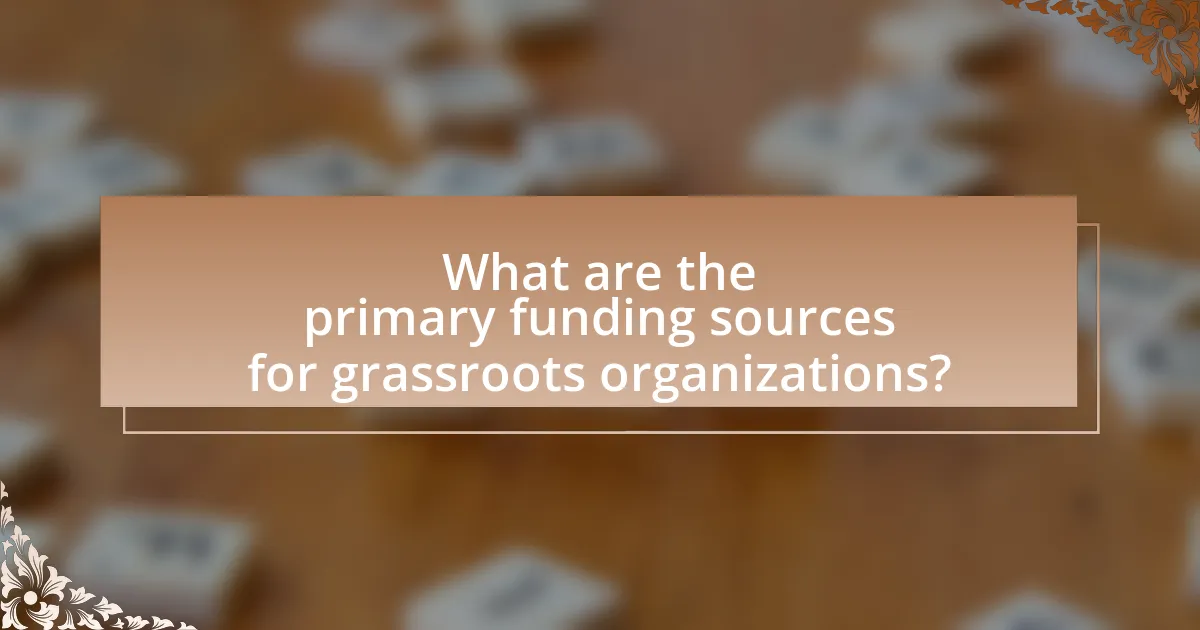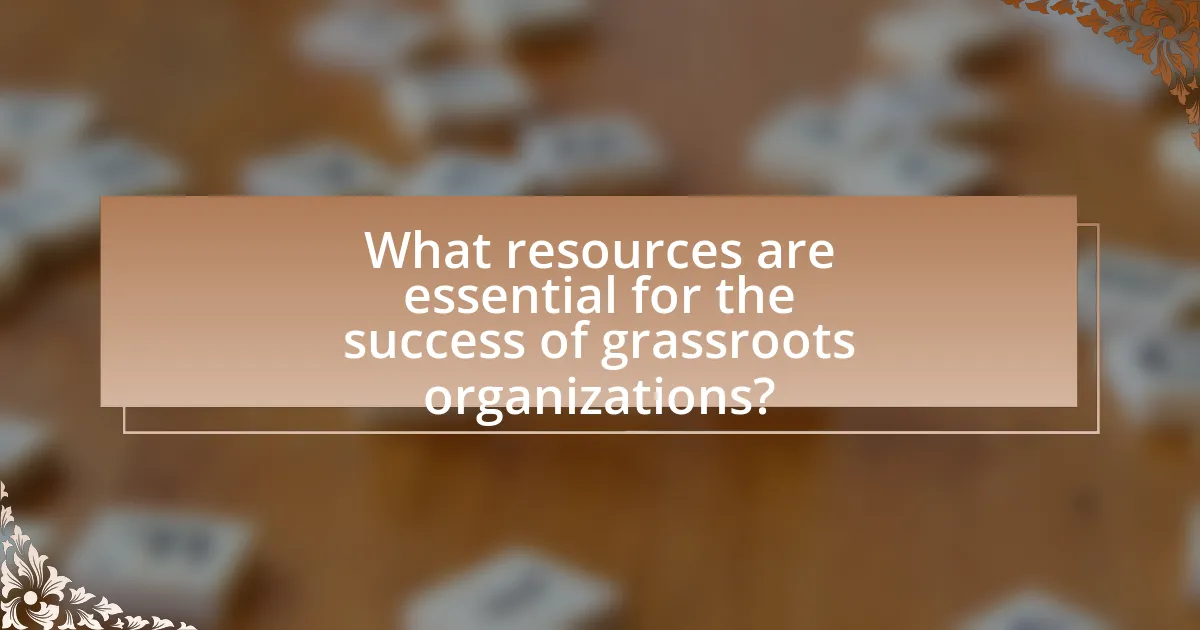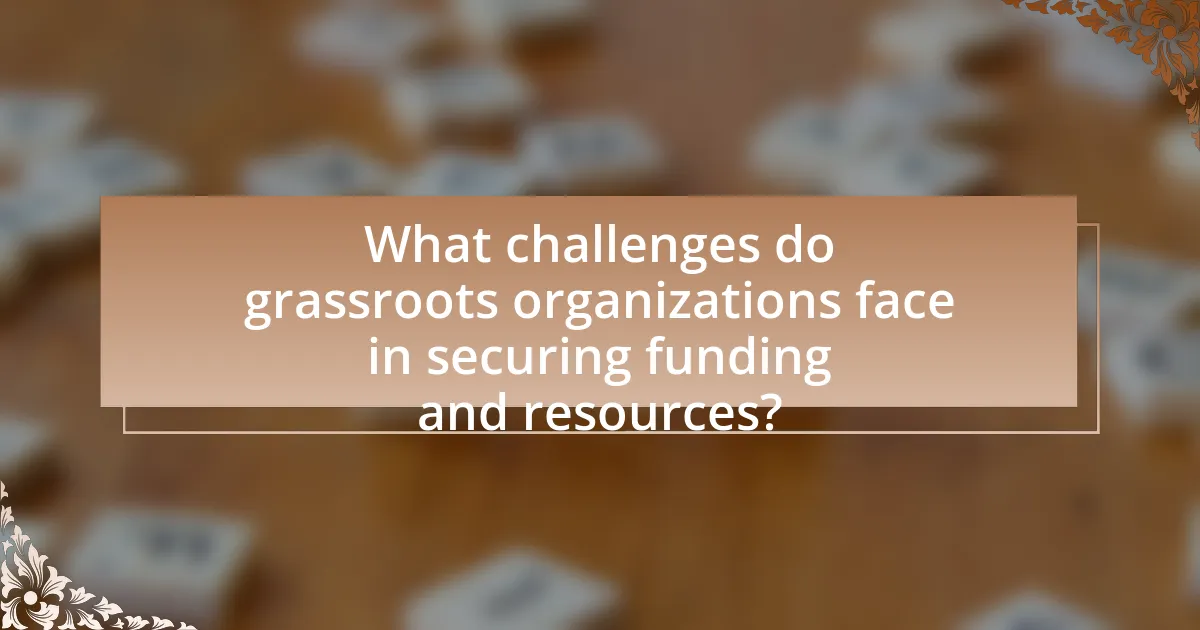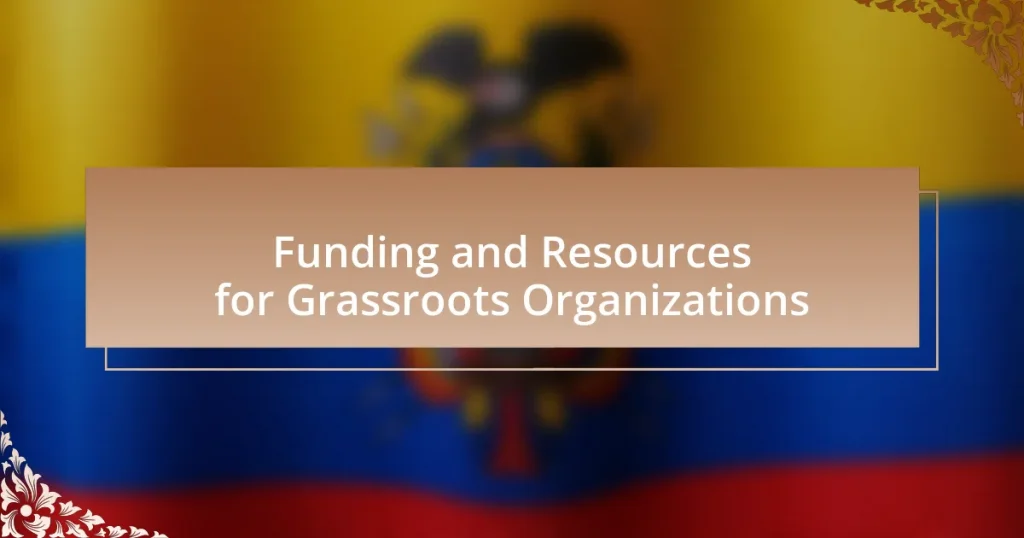Grassroots organizations are community-driven entities that rely on various funding sources to sustain their operations and initiatives. This article outlines the primary funding avenues available to these organizations, including individual donations, government grants, private foundations, crowdfunding, and corporate sponsorships. It further explores how government grants support grassroots initiatives, the role of private foundations in funding, and the benefits of crowdfunding platforms. Additionally, the article discusses strategies for effective grant applications, the importance of community partnerships, and the challenges grassroots organizations face in securing resources. By understanding these elements, grassroots organizations can enhance their funding strategies and operational effectiveness.

What are the primary funding sources for grassroots organizations?
The primary funding sources for grassroots organizations include individual donations, grants from foundations, crowdfunding, membership fees, and corporate sponsorships. Individual donations often represent a significant portion of funding, as grassroots organizations typically rely on community support. Grants from foundations provide targeted funding for specific projects or initiatives, with many foundations prioritizing social justice and community development. Crowdfunding platforms enable grassroots organizations to reach a wider audience and gather small contributions from many supporters. Membership fees create a sustainable revenue stream by engaging supporters in a more formalized way. Corporate sponsorships can also provide financial support, although they may come with specific expectations or conditions. These funding sources collectively enable grassroots organizations to operate and pursue their missions effectively.
How do government grants support grassroots initiatives?
Government grants support grassroots initiatives by providing essential financial resources that enable local organizations to implement community-driven projects. These grants often target specific social issues, such as education, health, and environmental sustainability, allowing grassroots groups to address local needs effectively. For instance, in the United States, the Community Development Block Grant program allocates billions annually to support local initiatives aimed at improving housing, economic development, and public services in low-income areas. This funding empowers grassroots organizations to mobilize community members, foster collaboration, and create sustainable solutions tailored to their unique contexts.
What types of government grants are available for grassroots organizations?
Grassroots organizations can access various types of government grants, including community development grants, capacity-building grants, and project-specific grants. Community development grants, such as those from the U.S. Department of Housing and Urban Development, support initiatives that improve local neighborhoods. Capacity-building grants, often provided by the Administration for Children and Families, enhance the operational effectiveness of organizations. Project-specific grants, like those from the National Endowment for the Arts, fund specific initiatives that align with governmental priorities. These grants are designed to empower grassroots organizations to address community needs effectively.
How can grassroots organizations effectively apply for government grants?
Grassroots organizations can effectively apply for government grants by thoroughly researching available funding opportunities and aligning their project goals with the grant’s objectives. This involves identifying specific grants that support community initiatives, understanding eligibility requirements, and tailoring proposals to demonstrate how their projects address the needs outlined in the grant guidelines.
Additionally, successful applications often include clear, measurable outcomes and a detailed budget that reflects responsible financial planning. According to the National Council of Nonprofits, organizations that engage in collaborative partnerships and leverage community support can enhance their proposals, making them more competitive. By following these strategies, grassroots organizations can increase their chances of securing government funding.
What role do private foundations play in funding grassroots organizations?
Private foundations play a crucial role in funding grassroots organizations by providing essential financial support that enables these groups to implement community-driven initiatives. These foundations often prioritize social change and community empowerment, aligning their funding strategies with the missions of grassroots organizations. For instance, according to the Foundation Center, in 2019, private foundations contributed over $70 billion in grants, with a significant portion directed towards grassroots efforts aimed at social justice, environmental sustainability, and community development. This funding not only helps grassroots organizations sustain their operations but also amplifies their impact by allowing them to scale their programs and reach more individuals in need.
What are the key characteristics of foundations that support grassroots efforts?
Foundations that support grassroots efforts typically exhibit characteristics such as a commitment to community engagement, flexibility in funding, and a focus on social justice. These foundations prioritize direct involvement with local communities, ensuring that their initiatives align with the needs and aspirations of those they aim to serve. For instance, the Ford Foundation emphasizes grassroots leadership and community-driven solutions, which enhances the effectiveness of their funding. Additionally, these foundations often provide unrestricted grants, allowing organizations the freedom to allocate resources where they are most needed, as seen in the practices of the Open Society Foundations. Lastly, a focus on social justice ensures that these foundations address systemic inequalities, which is crucial for fostering sustainable change in communities.
How can grassroots organizations build relationships with private foundations?
Grassroots organizations can build relationships with private foundations by engaging in consistent communication and demonstrating alignment with the foundation’s mission. Establishing a clear understanding of the foundation’s goals allows grassroots organizations to tailor their proposals and initiatives to meet those objectives. For instance, organizations can attend foundation-hosted events, participate in networking opportunities, and follow up with personalized outreach to foundation staff. Research indicates that foundations often prioritize grantees who show a commitment to collaboration and transparency, which can be evidenced by sharing impact stories and data that highlight the organization’s effectiveness. By fostering trust and demonstrating shared values, grassroots organizations can enhance their chances of securing funding and support from private foundations.
How do crowdfunding platforms benefit grassroots organizations?
Crowdfunding platforms benefit grassroots organizations by providing them with accessible funding opportunities that bypass traditional financial barriers. These platforms enable grassroots organizations to reach a wider audience, allowing them to gather small contributions from many individuals, which can accumulate into significant financial support. For instance, according to a report by the World Bank, crowdfunding has raised over $34 billion globally, demonstrating its effectiveness in mobilizing resources for various initiatives. Additionally, crowdfunding platforms often foster community engagement and awareness, as supporters are more likely to contribute to causes they feel personally connected to, thus enhancing the organization’s visibility and outreach.
What are the most popular crowdfunding platforms for grassroots initiatives?
The most popular crowdfunding platforms for grassroots initiatives include Kickstarter, GoFundMe, Indiegogo, and Patreon. Kickstarter is widely recognized for creative projects, allowing individuals to fund innovative ideas. GoFundMe is often used for personal causes and community projects, providing a straightforward way to raise funds. Indiegogo offers flexible funding options, catering to both creative and charitable initiatives. Patreon enables creators to receive ongoing support from their community through subscription-based funding. These platforms have collectively facilitated millions of dollars in funding for grassroots efforts, demonstrating their effectiveness in mobilizing community support.
How can grassroots organizations create successful crowdfunding campaigns?
Grassroots organizations can create successful crowdfunding campaigns by clearly defining their mission and engaging their community effectively. A well-articulated mission resonates with potential donors, making them more likely to contribute. Additionally, utilizing social media platforms to share compelling stories and updates fosters a sense of community and urgency, which can drive donations.
Research indicates that campaigns with a strong narrative and regular updates can increase funding by up to 50%. Furthermore, offering tangible rewards or recognition for different donation levels can incentivize contributions, as evidenced by successful campaigns that have implemented tiered reward systems. By combining a clear mission, community engagement, and strategic incentives, grassroots organizations can significantly enhance their crowdfunding success.

What resources are essential for the success of grassroots organizations?
Essential resources for the success of grassroots organizations include funding, community engagement, skilled volunteers, and access to information. Funding is critical as it provides the financial support necessary for operational costs, program development, and outreach efforts; for instance, a study by the National Council of Nonprofits indicates that organizations with diversified funding sources are more sustainable. Community engagement fosters local support and participation, which is vital for grassroots initiatives to thrive. Skilled volunteers contribute expertise and manpower, enhancing the organization’s capacity to achieve its goals. Access to information, including research and best practices, enables grassroots organizations to make informed decisions and adapt strategies effectively.
How can grassroots organizations leverage community partnerships?
Grassroots organizations can leverage community partnerships by collaborating with local businesses, nonprofits, and government entities to enhance resource sharing and support. These partnerships enable grassroots organizations to access funding opportunities, share expertise, and mobilize volunteers, thereby increasing their impact. For instance, a study by the National Council of Nonprofits highlights that organizations engaged in community partnerships often experience a 30% increase in funding and resource availability, demonstrating the tangible benefits of such collaborations.
What types of organizations make ideal partners for grassroots initiatives?
Nonprofit organizations, community foundations, and local businesses make ideal partners for grassroots initiatives. Nonprofits often share similar missions and can provide expertise, resources, and networks that enhance grassroots efforts. Community foundations typically have a deep understanding of local needs and can offer funding opportunities tailored to specific initiatives. Local businesses can contribute through sponsorships, in-kind donations, and volunteer support, fostering community engagement and strengthening local ties. These partnerships are essential for mobilizing resources and achieving sustainable impact in grassroots movements.
How can grassroots organizations approach potential partners effectively?
Grassroots organizations can approach potential partners effectively by clearly articulating their mission and demonstrating the mutual benefits of collaboration. Establishing a strong value proposition is essential; this involves outlining how the partnership aligns with the partner’s goals and objectives. Research indicates that partnerships are more successful when both parties see a clear advantage, such as increased visibility or access to new resources. For instance, a study by the National Council of Nonprofits highlights that organizations that present data-driven outcomes and community impact reports are more likely to attract funding and support from potential partners. By leveraging these strategies, grassroots organizations can enhance their chances of forming successful partnerships.
What role does volunteer support play in grassroots organizations?
Volunteer support is crucial for grassroots organizations as it provides essential manpower and resources that often exceed financial limitations. Grassroots organizations typically operate on tight budgets, and volunteers help to execute programs, organize events, and engage with the community without incurring significant costs. For instance, a study by the Corporation for National and Community Service found that volunteers contributed an estimated $184 billion worth of services in 2019, highlighting the economic impact of volunteerism. This support not only enhances operational capacity but also fosters community engagement and ownership, which are vital for the sustainability and effectiveness of grassroots initiatives.
How can grassroots organizations recruit and retain volunteers?
Grassroots organizations can recruit and retain volunteers by creating a strong sense of community and purpose. Engaging potential volunteers through clear communication of the organization’s mission and impact fosters interest and commitment. Research indicates that organizations with well-defined roles and responsibilities for volunteers experience higher retention rates, as volunteers feel valued and understand their contributions. Additionally, providing training and development opportunities enhances volunteers’ skills and satisfaction, leading to longer-term involvement. A study by the Corporation for National and Community Service found that organizations that recognize and celebrate volunteer contributions see a 20% increase in volunteer retention.
What training and resources do volunteers need to be effective?
Volunteers need training in specific skills relevant to their roles and access to resources that support their tasks to be effective. Effective training includes orientation sessions that cover organizational goals, role-specific skills, and communication techniques. Resources such as manuals, toolkits, and access to experienced mentors enhance volunteers’ capabilities. Research indicates that organizations providing structured training and ongoing support see a 50% increase in volunteer retention rates, demonstrating the importance of these elements in fostering effective volunteer engagement.
How can technology enhance the operations of grassroots organizations?
Technology can enhance the operations of grassroots organizations by streamlining communication, improving fundraising efforts, and facilitating data management. For instance, platforms like social media enable grassroots organizations to reach wider audiences quickly, increasing awareness and engagement. Additionally, crowdfunding websites such as GoFundMe or Kickstarter provide accessible avenues for raising funds, allowing organizations to gather resources from a larger pool of supporters. Furthermore, tools like CRM (Customer Relationship Management) systems help manage donor relationships and track contributions efficiently, which is crucial for sustaining operations. According to a report by the Nonprofit Technology Network, 70% of nonprofits that utilize technology for fundraising see increased donations, demonstrating the effectiveness of these tools in enhancing operational capabilities.
What tools and platforms are most beneficial for grassroots organizations?
Grassroots organizations benefit significantly from tools and platforms such as social media, crowdfunding sites, and community organizing software. Social media platforms like Facebook and Twitter enable grassroots organizations to reach a wider audience, engage supporters, and mobilize community action effectively. Crowdfunding sites like GoFundMe and Kickstarter provide essential funding opportunities, allowing organizations to raise money directly from their supporters. Additionally, community organizing software such as Mobilize and Action Network streamlines event planning, volunteer management, and communication, enhancing organizational efficiency. These tools collectively empower grassroots organizations to amplify their impact and sustain their initiatives.
How can grassroots organizations utilize social media for outreach?
Grassroots organizations can utilize social media for outreach by creating targeted campaigns that engage their community and raise awareness about their causes. These organizations can leverage platforms like Facebook, Twitter, and Instagram to share compelling stories, mobilize supporters, and disseminate information quickly. For instance, a study by the Pew Research Center found that 69% of adults in the U.S. use social media, making it an effective tool for reaching a broad audience. Additionally, social media allows grassroots organizations to interact directly with their followers, fostering a sense of community and encouraging participation in events or initiatives. By using analytics tools, these organizations can also track engagement metrics to refine their strategies and improve outreach efforts.

What challenges do grassroots organizations face in securing funding and resources?
Grassroots organizations face significant challenges in securing funding and resources, primarily due to limited visibility and recognition compared to larger entities. These organizations often struggle to attract funding from traditional sources such as government grants and large foundations, which tend to favor established nonprofits with proven track records. Additionally, grassroots organizations frequently lack the administrative capacity to navigate complex grant application processes, resulting in missed opportunities for financial support. According to a report by the National Council of Nonprofits, smaller organizations receive only a fraction of total philanthropic funding, highlighting the disparity in resource allocation. Furthermore, grassroots initiatives may also encounter difficulties in building relationships with potential donors, as they often operate within marginalized communities that are overlooked by mainstream funding channels.
What are the common obstacles in accessing funding for grassroots organizations?
Common obstacles in accessing funding for grassroots organizations include limited visibility, lack of established networks, and stringent funding criteria. Grassroots organizations often struggle to gain recognition compared to larger entities, which can hinder their ability to attract donors and funding opportunities. Additionally, many grassroots groups lack the connections and relationships with funding bodies that facilitate access to financial resources. Furthermore, funding criteria can be overly restrictive, requiring extensive documentation and specific project outcomes that may not align with the flexible and adaptive nature of grassroots initiatives. These challenges are supported by studies indicating that smaller organizations frequently face barriers in meeting the complex requirements set by funding agencies, limiting their financial sustainability and growth.
How can grassroots organizations overcome funding application challenges?
Grassroots organizations can overcome funding application challenges by developing strong relationships with funders and enhancing their proposal writing skills. Establishing connections with potential funders allows organizations to better understand funding priorities and tailor their applications accordingly. Additionally, investing in training for staff or volunteers on effective grant writing can significantly improve the quality of submissions. Research indicates that organizations with well-prepared proposals are more likely to receive funding; for instance, a study by the National Council of Nonprofits found that clear, concise, and compelling narratives increase the chances of success in grant applications.
What strategies can grassroots organizations use to diversify funding sources?
Grassroots organizations can diversify funding sources by implementing strategies such as building partnerships with local businesses, applying for grants, and engaging in crowdfunding campaigns. Partnerships with local businesses can provide mutual benefits, such as sponsorships or in-kind donations, which can enhance financial stability. According to the National Council of Nonprofits, over 60% of nonprofits report that corporate partnerships significantly contribute to their funding. Additionally, applying for grants from foundations and government entities can open up new revenue streams; in 2020, U.S. foundations awarded over $80 billion in grants, highlighting the potential for grassroots organizations to tap into this funding. Crowdfunding campaigns, which leverage social media and online platforms, can also attract small donations from a broad audience, with platforms like GoFundMe raising over $9 billion since its inception, demonstrating the effectiveness of this approach.
How do economic conditions impact funding for grassroots organizations?
Economic conditions significantly impact funding for grassroots organizations by influencing donor behavior and available financial resources. During economic downturns, individuals and corporations often reduce charitable contributions, leading to decreased funding for these organizations. For instance, a study by the Indiana University Lilly Family School of Philanthropy found that charitable giving tends to decline by approximately 2% for every 1% decrease in GDP. Conversely, in robust economic times, increased disposable income and corporate profits typically result in higher levels of donations, enabling grassroots organizations to expand their initiatives and outreach. Thus, the economic climate directly correlates with the financial viability and operational capacity of grassroots organizations.
What trends in the economy should grassroots organizations be aware of?
Grassroots organizations should be aware of the increasing emphasis on social impact investing as a key economic trend. This trend reflects a growing willingness among investors to fund initiatives that not only provide financial returns but also generate positive social and environmental outcomes. According to the Global Impact Investing Network, the impact investing market reached $715 billion in 2020, indicating a significant shift in funding priorities. Additionally, grassroots organizations should monitor the rise of digital fundraising platforms, which have become essential for mobilizing resources, especially during economic downturns. A report by Nonprofit Source states that online donations accounted for 13.5% of total fundraising in 2021, highlighting the importance of digital engagement strategies. Understanding these trends can help grassroots organizations adapt their funding strategies and enhance their resource mobilization efforts.
How can grassroots organizations adapt to changing economic conditions?
Grassroots organizations can adapt to changing economic conditions by diversifying their funding sources and enhancing community engagement. Diversification allows these organizations to reduce reliance on a single funding stream, which can be vulnerable to economic fluctuations. For instance, organizations can seek grants from multiple foundations, engage in crowdfunding, and develop partnerships with local businesses to create sustainable revenue streams.
Enhancing community engagement involves building strong relationships with local stakeholders, which can lead to increased support and resources during economic downturns. According to a report by the National Council of Nonprofits, organizations that actively involve their communities in decision-making processes are more resilient and better positioned to navigate economic challenges. This approach not only fosters loyalty but also encourages community members to contribute financially or through volunteer efforts, further stabilizing the organization’s resources.
What best practices can grassroots organizations adopt for sustainable funding?
Grassroots organizations can adopt several best practices for sustainable funding, including diversifying funding sources, building strong community relationships, and implementing effective fundraising strategies. Diversifying funding sources reduces reliance on a single donor or grant, which can stabilize finances; for instance, organizations can seek funding from individual donors, corporate sponsorships, and government grants. Building strong community relationships fosters local support and encourages community members to contribute financially or through in-kind donations, enhancing sustainability. Effective fundraising strategies, such as hosting events or leveraging online crowdfunding platforms, can also increase revenue streams. According to a report by the National Council of Nonprofits, organizations that engage in diverse funding practices are more resilient and better equipped to navigate financial challenges.
How can grassroots organizations create a long-term funding strategy?
Grassroots organizations can create a long-term funding strategy by diversifying their funding sources, establishing strong community partnerships, and developing a robust donor engagement plan. Diversification reduces reliance on a single funding stream, which can be risky; for instance, organizations can seek grants, individual donations, corporate sponsorships, and crowdfunding. Strong community partnerships enhance credibility and can lead to shared resources and funding opportunities. A robust donor engagement plan, which includes regular communication and recognition of donors, fosters long-term relationships and encourages sustained financial support. According to the National Council of Nonprofits, organizations that engage in diverse funding strategies are more resilient and better positioned for long-term sustainability.
What role does transparency play in securing funding for grassroots organizations?
Transparency is crucial in securing funding for grassroots organizations as it builds trust with potential donors and stakeholders. When organizations openly share their financial practices, project outcomes, and decision-making processes, they demonstrate accountability and integrity. Research indicates that 78% of donors are more likely to support organizations that provide clear and accessible information about their operations and impact. This level of transparency not only attracts funding but also fosters long-term relationships with supporters, enhancing the organization’s credibility and sustainability.










